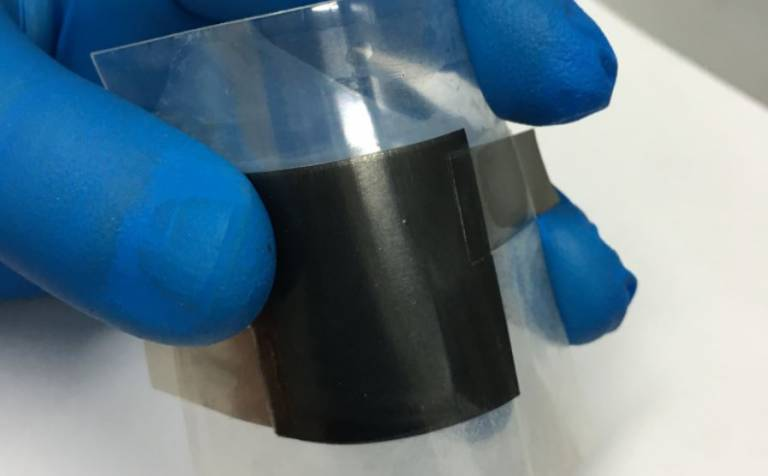Feb 18 2020
Scientists from University College London (UCL) and the Chinese Academy of Sciences have successfully developed and demonstrated a new graphene-based bendable supercapacitor that charges rapidly and safely preserves the highest amount of energy for use over a long period.
 New supercapacitor developed by UCL researchers. Image Credit: University College London.
New supercapacitor developed by UCL researchers. Image Credit: University College London.
At the proof-of-concept stage, the supercapacitor shows huge potential as a portable power supply in many viable applications, such as wearable technology, phones, and electric vehicles.
Recently published in the Nature Energy journal, this breakthrough discovery resolves the problem faced by fast-charging, high-powered supercapacitors; that is, these devices generally cannot accommodate a considerable amount of energy in a compact space.
Our new supercapacitor is extremely promising for next-generation energy storage technology as either a replacement for current battery technology, or for use alongside it, to provide the user with more power.
Dr Zhuangnan Li, Study First Author, Department of Chemistry, University College London
Li continued, “We designed materials which would give our supercapacitor a high power density—that is how fast it can charge or discharge—and a high energy density—which will determine how long it can run for. Normally, you can only have one of these characteristics but our supercapacitor provides both, which is a critical breakthrough.”
“Moreover, the supercapacitor can bend to 180 degrees without affecting performance and doesn’t use a liquid electrolyte, which minimizes any risk of explosion and makes it perfect for integrating into bendy phones or wearable electronics,” Li further added.
A group of physicists, engineers, and chemists worked on the latest design, which utilizes a novel graphene electrode material containing pores. The size of these pores can be modified to preserve the charge more efficiently.
This modification increases the supercapacitor’s energy density to a record 88.1 Wh/L. This energy density is the highest ever reported for supercapacitors based on carbon.
While analogous commercial and fast-charging technology has a relatively low energy density of only 5 to 8 Wh/L, conventional lead-acid batteries utilized in electric vehicles charge slowly but run for a longer time. These batteries usually have 50 to 90 Wh/L.
The supercapacitor created by the researchers also has a similar energy density as the advanced value of lead-acid batteries. But the power density of the new supercapacitor is two orders of magnitude higher at more than 10,000 W/L.
Successfully storing a huge amount of energy safely in a compact system is a significant step towards improved energy storage technology. We have shown it charges quickly, we can control its output and it has excellent durability and flexibility, making it ideal for development for use in miniaturised electronics and electric vehicles.
Ivan Parkin, Study Senior Author, Professor, and Dean, Mathematical & Physical Sciences, Department of Chemistry, University College London
Parkin continued, “Imagine needing only ten minutes to fully-charge your electric car or a couple of minutes for your phone and it lasting all day.”
The scientists developed electrodes from numerous graphene layers, producing a thick, yet porous, material that has the potential to trap different sizes of charged ions. By using an array of methods, the researchers characterized this material and discovered that it performed optimally when the sizes of the pores corresponded with the diameter of the ions present in the electrolyte.
The improved material, which creates a thin film, was used by the team to construct a proof-of-concept device with a high energy density as well as high power.
The supercapacitor measuring 6 cm x 6 cm was fabricated from a pair of identical electrodes layered on both sides of a gel-like substance. This substance served as a chemical medium for transferring electrical charges. The supercapacitor was utilized to power many numbers of light-emitting diodes (LEDs) and was observed to be stable, flexible, and highly sturdy.
Even when the supercapacitor was bent at 180°, it performed virtually the same as when it was flat, and following 5,000 cycles, it was able to retain its capacity of 97.8%.
Over the next thirty years, the world of intelligent technology will accelerate, which will greatly change communication, transportation and our daily lives. By making energy storage smarter, devices will become invisible to us by working automatically and interactively with appliances.
Feng Li, Study Senior Author and Professor, Chinese Academy of Sciences
Feng Li continued, “Our smart cells are a great example of how the user experience might be improved and they show enormous potential as portable power supply in future applications.”
The National Science Foundation of China, the Chinese Academy of Science, the Ministry of Science and Technology of China, and the EPSRC funded the study.